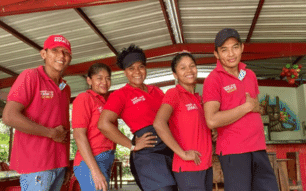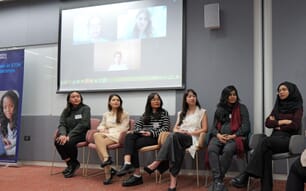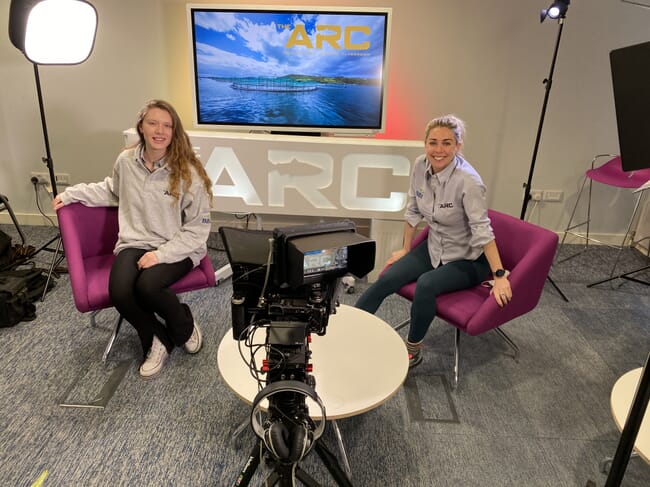
Aine-Lisa Shannon (L) and Aine O'Donnell (R) are educational facilitators on the Aquaculture Remote Classroom (ARC)
Can you briefly describe your aquaculture careers and how you came to the sector?
AO: I didn’t immediately fall into aquaculture as a career. I came to the industry through a job with H2 Learning to act as facilitator for the Bord Iascaigh Mhara (BIM) Aquaculture Remote Classroom (ARC). I’m a people person and I genuinely care about the decisions people make regarding their personal health, wellness and the health of the planet. I’m a scientist and I’ve invested over 10 years of my career into research, education and communications. I love to educate people about important topics that will ultimately enhance their quality of life. Seafood has a huge role to play in not only human health but also in providing a sustainable form of protein for people globally. My family is from Donegal in Northwest Ireland and aquaculture is hugely important for many coastal communities. I’ve supported the industry and my current role is perfectly aligned with my strengths and my values – it was a perfect door to the industry.
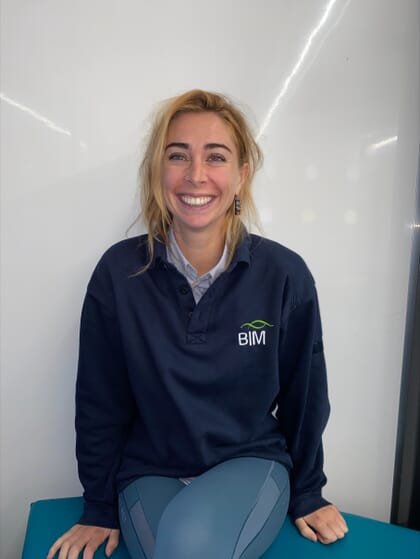
O'Donnell got her start in nutrition sciences before joining the ARC project
AO: My career in aquaculture is totally centred around education, public outreach and science communications. My main job as facilitator for BIM’s ARC is to educate the primary and second level students about the aquaculture industry and its role in global food security, human health, economic development and climate adaptation. The BIM ARC is part of a wider EU project, #FarmedintheEU, focused on building awareness of how seafood is farmed among younger audiences. To do this, BIM developed a mobile classroom that delivers aquaculture workshops and engages in public outreach events. BIM literally put a classroom on wheels and takes it to schools and events to help build understanding about aquaculture. BIM also host webinars, collaborations and creates online learning resources.
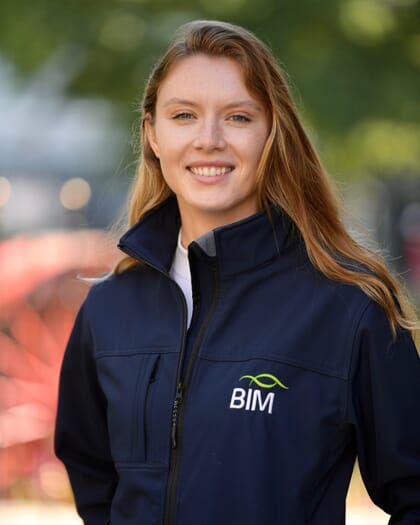
Shannon has a background in marine biology and previously worked for Ireland's Marine Institute
AS: On my side, I’m outdoorsy and very oriented towards animals. Coming from county Clare in the West of Ireland, I’ve always been by the coast. When I started to think about my career path, I didn’t think I’d have the stomach to be a vet – I thought I’d study something like zoology. But I went to a university open day and saw the marine biology department – I didn’t realise you could do marine biology as a career! I loved the idea of diving and being at sea as a job. I started out by getting a bachelor’s degree in marine biology from National University of Ireland, Galway and went on to do a master’s degree at University College Cork. After I graduated, I spent a year working on research vessels as an observer. Any foreign vessels that come into Irish waters need to have an Irish scientist on board – so it meant I could spend a lot of time at sea. The trips touched on multiple disciplines like oceanography, deep sea monitoring and fisheries science. I also worked at Ireland’s Marine Institute. While I was there, I found that science communications and public outreach are some of my key strengths. Aquaculture was always a background interest – I just didn’t have a chance to pursue it professionally until I learned about the ARC project.
AS: Aquaculture is closely aligned with a lot of my strengths, especially when it comes to communications and teaching the public. When I saw an opportunity to work as a BIM ARC facilitator, I went for it. I’ve been on the project for two years and even though I’m leaving, it will always stand out as a career highlight. My role as a facilitator gives me a way to pursue that side of my career – I really think my future is with the sector. Aquaculture is growing fast but there still seems to be low awareness about the industry in Ireland. I’ve found that some people have been exposed to misleading data, despite aquaculture being a highly sustainable way of producing food. My work has definitely sparked a passion for aquaculture.
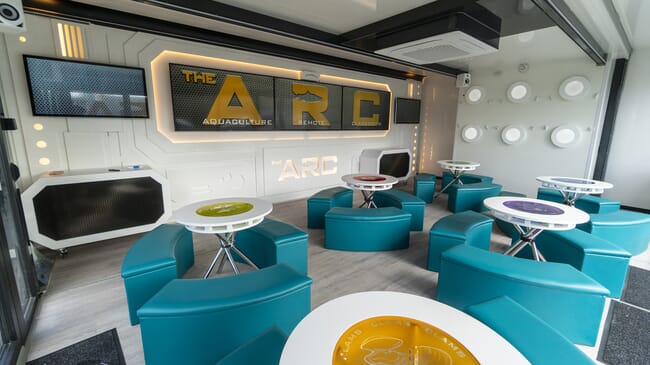
Shannon and O'Donnell use presentations, practical activities and interactive elements to give students an immersive learning experience
What does a typical day in the BIM ARC consist of?
AO: A typical day in the ARC starts with the ARC@School programme offered to 5th and 6th class primary students (ages 11 to 12). We run a full day of workshops from 9:30 am to 2 pm that focus on commercial species that are farmed in Ireland – organic Atlantic salmon, mussels and oysters. We also touch on production of trout and seaweed.
We use presentations, practical activities and interactive elements like VR to give the students a really immersive learning experience. Throughout the day we cover five main topics which have been carefully aligned to the primary curriculum, STEM and key objectives in the #FarmedintheEU project.
AS: Module 1 covers history, the farming timeline, the biology of Ireland’s commercial aquaculture species and how these species are farmed in Irish waters. Module 2 covers geography and science and discusses the role of weather and climate on farming productivity and efficiency. Module 3 looks at jobs and resources and how geographical locations – whether rural, urban or coastal – play a massive role in the type of work available to communities here and abroad. Module 4 discusses the role of seafood consumption as part of a balanced diet, highlights the key nutrients found in seafood and why they are important. Last module concludes with a big positive message about aquaculture. It highlights the sector’s role in global food security, how it provides a climate-friendly protein, how it reduces pressure on our finite resources and a gentle reminder to respect the planet.

Ireland's aquaculture industry produces organic Atlantic salmon, oysters, mussels and seaweed
How has the ARC changed since it began in 2018?
AO: During the Covid-19 pandemic the ARC was temporarily taken off the road. However, attendance at BIM's ARC modules increased when the modules were adapted to an online format and also developed webinars, educational videos and interactive online games for students, expanding its reach.
What’s your favourite part of working in aquaculture and the ARC?
AO: For me, it’s the educational aspect. Before working as a facilitator on BIM’s ARC, I worked in the health and wellness space and I’ve always had a passion for educating people about important topics that will improve their quality of life. After the pandemic, we all recognised the inextricable link between healthy people, healthy societies and a healthy planet. Working on BIM’s ARC allows me to educate and raise awareness about the health benefits of eating seafood and that eating sustainable seafood can support the environment and relieve pressure on our natural resources. I get to blend my former qualifications with my current ones. It’s a win-win and I get total job satisfaction.
AS: I love teaching the kids about aquaculture – the geography and climate modules really stand out as well. Kids are like sponges; they learn so much and they really engage with it. Going through the activities is great. Since we can’t take kids to an active oyster or salmon farm, we use VR headsets to show the students how these sites operate. It lets them fly through the air with a drone and see the size and scale of aquaculture – it really hits home.
What work-related achievements are you most proud of?
AS: For me, raising awareness about aquaculture and the benefits it brings stands out. I’ve been doing a lot of outreach, leading presentations and holding info sessions on the industry. When I get to tell people about how their food gets to their plates, I know that I’m helping to build awareness.
AO: Since I didn’t come from a traditional aquaculture background, my biggest achievement is learning how to educate students and consumers about an industry I knew nothing about before this role. I did a lot of independent research and field visits when I started out. I’m always upskilling so I can offer more in the role. Last year I finished a postgraduate degree that focused on business and the bioeconomy and I started a family as well. 2021 was a big year for me!
Are there any individuals or organisations in aquaculture that you’ve found particularly inspirational?
AO: Yes! At BIM, Catherine Barrett has been a huge support and really inspired me on my journey. She works as a fisheries improvement officer and has helped build my confidence in the industry. I’ve put myself forward for positions and opportunities that I wouldn’t have otherwise because of her. I also need to mention Richard Donnelly at BIM – he told me about the ARC before it went on the road. I wouldn’t be working in the marine sector without him.
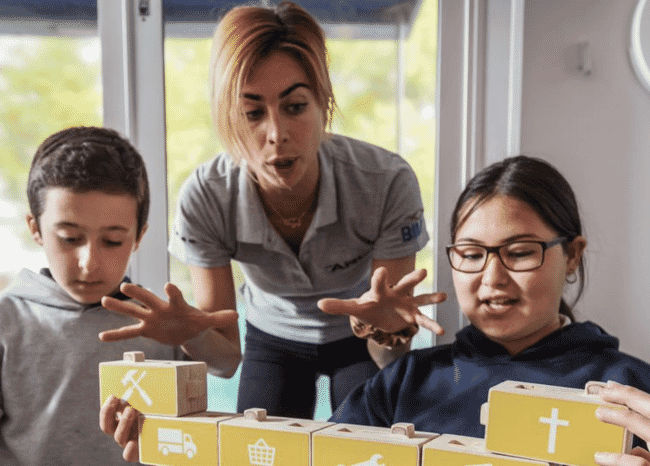
The ARC project is raising awareness of sustainable seafood and the role it plays in healthy diets
AS: There were multiple people in the Marine Institute who inspired me and steered me towards science communications. Caroline Bocquel at BIM definitely encouraged me and I’ve been mentored by so many people at BIM who helped me progress to where I am now. My colleagues at BIM like Trish Daly, Mary Hannon and Mairtín Walsh helped me get some hands-on aquaculture experience – it’s been invaluable.
What advice would you give to women who are considering joining the aquaculture sector?
AS: I know that the industry has the reputation of being male-dominated and that it involves a lot of heavy work, but that’s not always the case. There are technical routes and academic ones – Aine and I just happened to take the academic route, but there really is a job for every type of person in the industry. It can be hard to start off, but I think that’s true of the marine industry in general. It’s competitive. You have to be determined to continue on, but it’s worth it. I think women are taking over these days – go for it!
AO: No dream is too big. I used to think that I could never work outside of health and wellness. I forgot that I’m a scientist and with that, you learn how to take on anything. When you work in the sciences, you develop strong research, analytical and problem-solving skills that can be successfully adapted to most sectors. It took me a long time to learn how to articulate my strengths in a professional setting – but you can get that down with a bit of practice. My advice would be to get out there and start networking with people in the industry. Learn the language and the parts that excite you the most.
Networking is key – reach out to people who are presenting webinars and invite them for a virtual coffee. Most people are keen to give into their area of research and want to share their expertise. They almost always want to help. When you’re just starting out, it’s hard to see where you fit in the puzzle or what you can bring to the table. But if you have someone who has that experience and you tell them what you like, they can give you invaluable advice that can take you forward. Use LinkedIn to start building your own community who can support you on your career path.
Where do you see the ARC in 10 years’ time?
AS: I don’t think people realised how popular the initiative would be! I hope BIM’s ARC concept will expand to other European countries. I believe there are a lot of EU regions where this kind of education project would be beneficial.
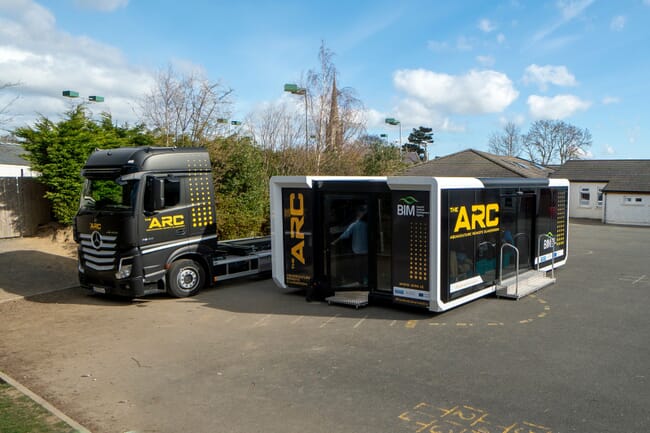
The ARC concept may gain traction and spread to other European countries
What would you two like to be doing in 10 years’ time?
AO: CEO of the Irish Food Board, Bord Bia! Honestly, I don’t know. I know I want to take my recent qualification and specialise in a role where I can research full-time and develop and implement solutions to address some of the biggest challenges we face. It’s important to keep an open mind and I’ll engage with as many opportunities as possible. I’m going to throw myself in the deep end – I don’t know what doors will be open, but I’ll find out.
AS: I’m aiming high! I definitely want to work towards a management and leadership position in the marine industry. I’m not there yet, I’ve still got a lot to learn, but I know I want to be active on the communications side. I don’t know where it will be exactly, but that’s the beauty of the marine industry. You don’t know where you’ll end up, but you learn as you go and thus far, it’s always taken me to a good place.


